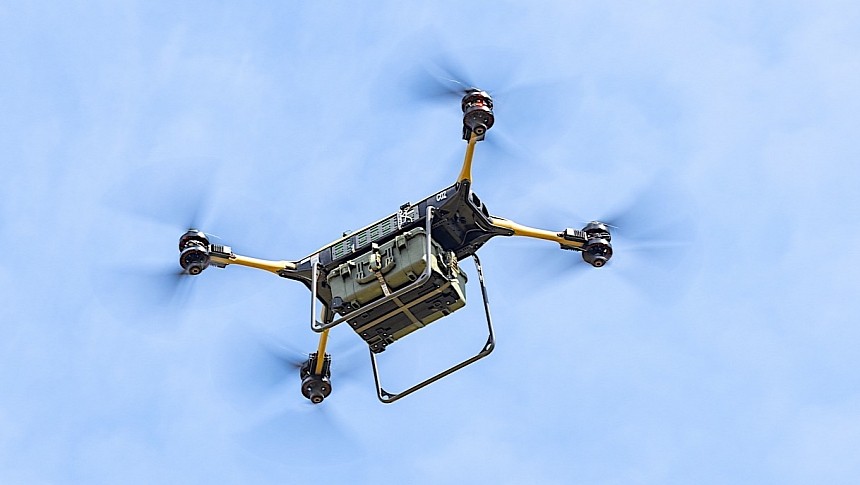Warfare is a messy business, but few times is that reality more apparent than when soldiers are left fighting some battle a very long way from a functional supply route. Whether spearheading an attack far ahead of the main force, or surviving a siege in the middle of nowhere, the success of the mission oftentimes depends on access to ammo, food, water, and medicine.
Generally speaking any military in this world will try to resupply its troops no matter what. When the conditions are right, that leads to huge losses among logistics troops as well, no matter if they use trucks or aircraft to conduct their mission.
There is a way to get supplies to where they're needed, even in contested environments, that only poses a risk to the transport hardware and the supplies themselves: using drones. And that's exactly what the U.S. Navy and Marine Corps plan on doing from now on.
A while back these branches of the military tasked a company called Survice Engineering with coming up with a drone system that could allow supply transport to remote locations with zero risk to military personnel.
Survice responded with the drones you see here, something called the TRV-150C. The military calls the drones TRUAS, which is the acronym for Tactical Resupply Unmanned Aircraft System.
Each such drone is operated by a pair of sailors or Marines, and can carry up to 150 pounds (68 kg) of cargo to distances of up to nine miles (14 km). The cargo can be anything, meaning food, ammo, medical supplies, and even batteries.
More importantly, this land-based machine is capable of automated launch and landing, and can navigate its way through pre-set waypoints. If landing is not possible, the payload can be dropped from the air.
The TRUAS has been in development for four years now, but at the end of October the Navy declared Initial Operational Capability for a fleet of six TRV-150C drones. That means to minimum useful deployable attributes of the system have been met, opening the doors to an entirely new way of conducting warfare.
The milestone was reached at Marine Corps Base Hawaii on October 27, at the end of no less than 36 training flights conducted over a short period of time. The six drones are now deployed with the Third Littoral Logistics Battalion (LLB-3) in Kaneohe Bay.
Back in April, when the contract was awarded to Survice, there was talk of the Department of Defense purchasing a total of 21 TRUAS drones. The value of the contract is $8.4 million, and includes a year of systems engineering program management services. The entire fleet should be in the service of the Navy by March 2024.
Because this is new tech, the Navy plans to create a new military occupational specialty for supply drone operations. It's called Small Unmanned Logistics System - Air Specialist.
There is a way to get supplies to where they're needed, even in contested environments, that only poses a risk to the transport hardware and the supplies themselves: using drones. And that's exactly what the U.S. Navy and Marine Corps plan on doing from now on.
A while back these branches of the military tasked a company called Survice Engineering with coming up with a drone system that could allow supply transport to remote locations with zero risk to military personnel.
Survice responded with the drones you see here, something called the TRV-150C. The military calls the drones TRUAS, which is the acronym for Tactical Resupply Unmanned Aircraft System.
Each such drone is operated by a pair of sailors or Marines, and can carry up to 150 pounds (68 kg) of cargo to distances of up to nine miles (14 km). The cargo can be anything, meaning food, ammo, medical supplies, and even batteries.
More importantly, this land-based machine is capable of automated launch and landing, and can navigate its way through pre-set waypoints. If landing is not possible, the payload can be dropped from the air.
The TRUAS has been in development for four years now, but at the end of October the Navy declared Initial Operational Capability for a fleet of six TRV-150C drones. That means to minimum useful deployable attributes of the system have been met, opening the doors to an entirely new way of conducting warfare.
The milestone was reached at Marine Corps Base Hawaii on October 27, at the end of no less than 36 training flights conducted over a short period of time. The six drones are now deployed with the Third Littoral Logistics Battalion (LLB-3) in Kaneohe Bay.
Back in April, when the contract was awarded to Survice, there was talk of the Department of Defense purchasing a total of 21 TRUAS drones. The value of the contract is $8.4 million, and includes a year of systems engineering program management services. The entire fleet should be in the service of the Navy by March 2024.
Because this is new tech, the Navy plans to create a new military occupational specialty for supply drone operations. It's called Small Unmanned Logistics System - Air Specialist.






